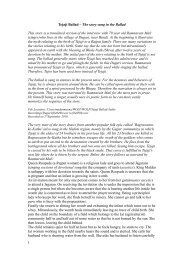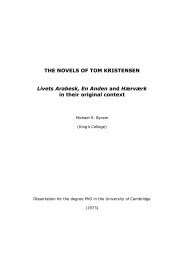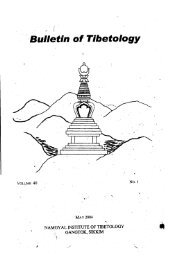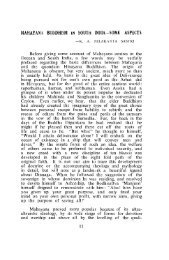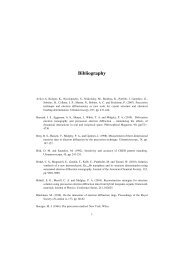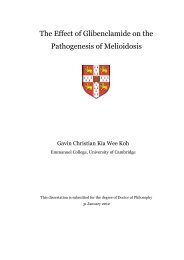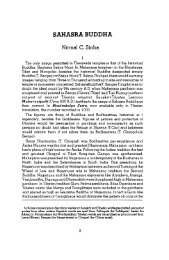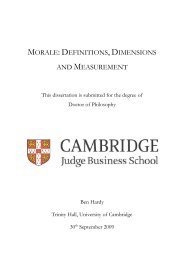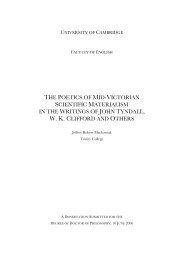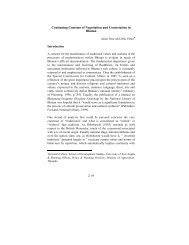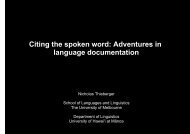The Crusades, the Genoese and the Latin East - DSpace at ...
The Crusades, the Genoese and the Latin East - DSpace at ...
The Crusades, the Genoese and the Latin East - DSpace at ...
You also want an ePaper? Increase the reach of your titles
YUMPU automatically turns print PDFs into web optimized ePapers that Google loves.
Although Friedman did not explicitly say so, she seemed to have concentr<strong>at</strong>ed in her<br />
book on <strong>the</strong> period of <strong>the</strong> first kingdom of Jerusalem. This is perhaps why she did not pay more<br />
<strong>at</strong>tention to Innocent's most important action with regard to captives, in <strong>the</strong> form of a crusade.<br />
Indeed, it can be argued th<strong>at</strong> Innocent's ideas about captivity <strong>and</strong> ransom had more important <strong>and</strong><br />
direct consequences than portrayed by Friedman. It was not merely an <strong>at</strong>tempt to spread a new<br />
notion or to change <strong>the</strong> image of captivity. It was not even just an effort to encourage <strong>the</strong> ransom<br />
of captives as an act of charity; Innocent III sent <strong>the</strong> people of Europe on a crusade because of<br />
th<strong>at</strong> issue. <strong>The</strong> captivity <strong>and</strong> servitude of Christians were a central reason behind <strong>the</strong> embark<strong>at</strong>ion<br />
of <strong>the</strong> Fifth Crusade.<br />
<strong>The</strong> evidence of Innocent's approach is found in numerous documents. As early as <strong>the</strong><br />
beginning of 1212 <strong>the</strong>re is evidence of communic<strong>at</strong>ion between Innocent <strong>and</strong> <strong>the</strong> Melkite<br />
p<strong>at</strong>riarch of Alex<strong>and</strong>ria, through whom Innocent also managed to establish direct correspondence<br />
with <strong>the</strong> captives in Alex<strong>and</strong>ria. On 19 January 1212 Innocent wrote a letter which he addressed<br />
to `universes captivis in Alex<strong>and</strong>ria et Babilonia. ' <strong>The</strong> letter begins with an acknowledgment of<br />
<strong>the</strong> reception of letters from <strong>the</strong> p<strong>at</strong>riarch <strong>and</strong> <strong>the</strong> captives about <strong>the</strong>ir `doloribus plenas et<br />
miseriis cumul<strong>at</strong>as. ' Innocent's letter is <strong>the</strong> first sign of direct communic<strong>at</strong>ion between <strong>the</strong> papacy<br />
<strong>and</strong> <strong>the</strong> captives. From <strong>the</strong> pope's reply, it was made clear th<strong>at</strong> <strong>the</strong> captives' only hope <strong>at</strong> <strong>the</strong><br />
beginning of 1212 was to gain <strong>the</strong>ir freedom through exchange with Muslim captives. <strong>The</strong> pope<br />
assured <strong>the</strong> captives th<strong>at</strong> he instructed <strong>the</strong> Christian leaders in <strong>the</strong> east, including <strong>the</strong> Templars<br />
<strong>and</strong> <strong>the</strong> Hospitallers, to work for <strong>the</strong> goal of <strong>the</strong>ir liber<strong>at</strong>ion <strong>and</strong> not to hesit<strong>at</strong>e to utilise for th<strong>at</strong><br />
purpose <strong>the</strong> Muslims <strong>the</strong>y held in captivity277<br />
On 26 April 1213, Innocent wrote to <strong>the</strong> Sultan al-'Adil Sayf ad-Din Abü Bakr. Ile<br />
presented his dem<strong>and</strong>s in a forthright manner:<br />
... ne propter violentam detentionen: praef<strong>at</strong>ae terrae plus adhuc effund<strong>at</strong>ur humani<br />
sanguinis quam hactenus est effusum, saniori utens consilio restituas earn nobis, de cujus<br />
detentione, praeter inanem gloriam, forte plus tibi difficult<strong>at</strong>is quam utilit<strong>at</strong>is accrescit;<br />
ipsaque reddita, et dimissis utrinque captivis, quiescamus a mutuis impugn<strong>at</strong>ionum<br />
offensis; ita quod apud to non sit deterior conditio geniis nostrae quam apud nos esi<br />
conditio genus tuae (my emphasis). 78<br />
<strong>The</strong> letter makes it clear th<strong>at</strong> <strong>the</strong> liber<strong>at</strong>ion of <strong>the</strong> Holy L<strong>and</strong> <strong>and</strong> <strong>the</strong> Christian captives<br />
were for Innocent a casus belli. He preached this idea in western Europe <strong>and</strong> thre<strong>at</strong>ened <strong>the</strong><br />
enemy in <strong>the</strong> east. Two issues spring to mind when reading <strong>the</strong>se letters. <strong>The</strong> first issue concerns<br />
<strong>the</strong> captives <strong>the</strong>mselves: How serious was <strong>the</strong> problem: how many Christians were in <strong>the</strong><br />
Egyptian prisons? In o<strong>the</strong>r words, did this problem justify a call for a crusade? <strong>The</strong> o<strong>the</strong>r issue<br />
th<strong>at</strong> requires some clarific<strong>at</strong>ion is <strong>the</strong> rel<strong>at</strong>ionship between east <strong>and</strong> west. Indeed such<br />
277<br />
PL 216, no. 148, p. 509. Cipollone, lbid, appendix 42, pp. 533-534.<br />
278<br />
PL, 216, no. 37, p. 832A<br />
86



